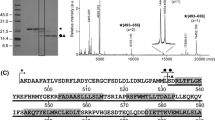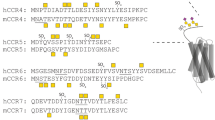Abstract
In order to link structural features on a molecular level to the function of chemokines, site-specific modification strategies are strongly required. These can be used to incorporate fluorescent dyes and/or physical probes to allow investigations in a wide range of biological and physical techniques, e.g., nuclear magnetic resonance (NMR) spectroscopy, fluorescence microscopy, fluorescence resonance energy transfer (FRET), or fluorescence correlation spectroscopy (FCS). Only a limited number of functional groups within the 20 canonical amino acids allow ligation strategies that can be helpful to introduce novel functionalities, which in turn expand the scope of chemoselective and orthogonal reactivity of (semi)synthetic chemokines. In the present chapter we mainly focus on the fabulous history of native chemical ligation (NCL) and provide a general protocol for the preparation of C-terminally modified SDF-1α including tips and tricks for practical work. We believe that this protocol can be easily adapted to other chemokines and many proteins in general.
Access this chapter
Tax calculation will be finalised at checkout
Purchases are for personal use only
Similar content being viewed by others
References
Schnolzer M, Kent SB (1992) Constructing proteins by dovetailing unprotected synthetic peptides: backbone-engineered HIV protease. Science 256:221–225
Dawson PE et al (1994) Synthesis of proteins by native chemical ligation. Science 266:776–779
Hackeng TM, Griffin JH, Dawson PE (1999) Protein synthesis by native chemical ligation: expanded scope by using straightforward methodology. Proc Natl Acad Sci U S A 96:10068–10073
Wieland T et al (1953) Ueber Peptidsynthesen. 8. Bildung von S-haltigen Peptiden durch intramolekulare Wanderung von Aminoacylresten. Liebigs Ann Chem 583:129–149
Zhang LS, Tam JP (1997) Orthogonal coupling of unprotected peptide segments through histidyl amino terminus. Tetrahedron Lett 38:3–6
Raines RT, Hondal RJ, Nilsson BL (2001) Selenocysteine in native chemical ligation and expressed protein ligation. J Am Chem Soc 123:5140–5141
Bang D et al (2006) Dissecting the energetics of protein alpha-helix C-cap termination through chemical protein synthesis. Nat Chem Biol 2:139–143
Bang D et al (2005) Total chemical synthesis and X-ray crystal structure of a protein diastereomer: [D-Gln 35]ubiquitin. Angew Chem Int Ed Engl 44:3852–3856
Yan LZ, Dawson PE (2001) Synthesis of peptides and proteins without cysteine residues by native chemical ligation combined with desulfurization. J Am Chem Soc 123:526–533
Bernardes GJ et al (2008) Facile conversion of cysteine and alkyl cysteines to dehydroalanine on protein surfaces: versatile and switchable access to functionalized proteins. J Am Chem Soc 130:5052–5053
Wan Q, Danishefsky SJ (2007) Free-radical-based, specific desulfurization of cysteine: a powerful advance in the synthesis of polypeptides and glycopolypeptides. Angew Chem Int Ed Engl 46:9248–9252
Crich D, Banerjee A (2007) Native chemical ligation at phenylalanine. J Am Chem Soc 129:10064–10065
Chen J et al (2008) Native chemical ligation at valine: a contribution to peptide and glycopeptide synthesis. Angew Chem Int Ed Engl 47:8521–8524
Haase C, Rohde H, Seitz O (2008) Native chemical ligation at valine. Angew Chem Int Ed Engl 47:6807–6810
Liu XW et al (2009) Dual native chemical ligation at lysine. J Am Chem Soc 131:13592–13593
Harpaz Z et al (2010) Protein synthesis assisted by native chemical ligation at leucine. ChemBioChem 11:1232–1235
Chen J et al (2010) A program for ligation at threonine sites: application to the controlled total synthesis of glycopeptides. Tetrahedron 66:2277–2283
Danishefsky SJ et al (2011) An advance in proline ligation. J Am Chem Soc 133:10784–10786
Brik A et al (2006) Sugar-assisted glycopeptide ligation. J Am Chem Soc 128:5626–5627
Ficht S et al (2007) Second-generation sugar-assisted ligation: a method for the synthesis of cysteine-containing glycopeptides. Angew Chem Int Ed Engl 46:5975–5979
Yang YY et al (2007) Sugar-assisted ligation in glycoprotein synthesis. J Am Chem Soc 129:7690–7701
Chong S et al (1997) Single-column purification of free recombinant proteins using a self-cleavable affinity tag derived from a protein splicing element. Gene 192:271–281
Chong S et al (1998) Utilizing the C-terminal cleavage activity of a protein splicing element to purify recombinant proteins in a single chromatographic step. Nucleic Acids Res 26:5109–5115
Hirata R et al (1990) Molecular structure of a gene, VMA1, encoding the catalytic subunit of H(+)-translocating adenosine triphosphatase from vacuolar membranes of Saccharomyces cerevisiae. J Biol Chem 265:6726–6733
Kane PM et al (1990) Protein splicing converts the yeast TFP1 gene product to the 69-kD subunit of the vacuolar H(+)-adenosine triphosphatase. Science 250:651–657
Klabunde T et al (1998) Crystal structure of GyrA intein from Mycobacterium xenopi reveals structural basis of protein splicing. Nat Struct Biol 5:31–36
David R, Richter MP, Beck-Sickinger AG (2004) Expressed protein ligation. Method and applications. Eur J Biochem 271:663–677
Muir TW, Sondhi D, Cole PA (1998) Expressed protein ligation: A general method for protein engineering. Proc Natl Acad Sci U S A 95:6705–6710
Southworth MW et al (1999) Purification of proteins fused to either the amino or carboxy terminus of the Mycobacterium xenopi gyrase A intein. Biotechniques 27:110–114, 116, 118–120
Baumann L, Beck-Sickinger AG (2010) Identification of a potential modification site in human stromal cell-derived factor-1. Biopolymers 94:771–778
Bellmann-Sickert K, Baumann L, Beck-Sickinger AG (2010) Selective labelling of stromal cell-derived factor 1alpha with carboxyfluorescein to study receptor internalisation. J Pept Sci 16:568–574
David R, Beck-Sickinger AG (2007) Identification of the dimerisation interface of human interleukin-8 by IL-8-variants containing the photoactivatable amino acid benzoyl-phenylalanine. Eur Biophys J 36:385–391
David R, Machova Z, Beck-Sickinger AG (2003) Semisynthesis and application of carboxyfluorescein-labelled biologically active human interleukin-8. Biol Chem 384:1619–1630
Steinhagen M et al (2011) Simultaneous “one pot” expressed protein ligation and CuI-catalyzed azide/alkyne cycloaddition for protein immobilization. ChemBioChem 12:2426–2430
Bellmann-Sickert K, Beck-Sickinger AG (2011) Palmitoylated SDF1alpha shows increased resistance against proteolytic degradation in liver homogenates. ChemMedChem 6:193–200
Dumy P et al (1998) Hydrazinolysis of Dde: complete orthogonality with Aloc protecting groups. Tetrahedron Lett 39:1175–1178
Dechavanne V et al (2011) A high-throughput protein refolding screen in 96-well format combined with design of experiments to optimize the refolding conditions. Protein Expr Purif 75:192–203
Author information
Authors and Affiliations
Editor information
Editors and Affiliations
Rights and permissions
Copyright information
© 2013 Springer Science+Business Media, New York
About this protocol
Cite this protocol
Baumann, L., Steinhagen, M., Beck-Sickinger, A.G. (2013). Preparation of C-terminally Modified Chemokines by Expressed Protein Ligation. In: Jensen, K., Tofteng Shelton, P., Pedersen, S. (eds) Peptide Synthesis and Applications. Methods in Molecular Biology, vol 1047. Humana Press, Totowa, NJ. https://doi.org/10.1007/978-1-62703-544-6_7
Download citation
DOI: https://doi.org/10.1007/978-1-62703-544-6_7
Published:
Publisher Name: Humana Press, Totowa, NJ
Print ISBN: 978-1-62703-543-9
Online ISBN: 978-1-62703-544-6
eBook Packages: Springer Protocols




